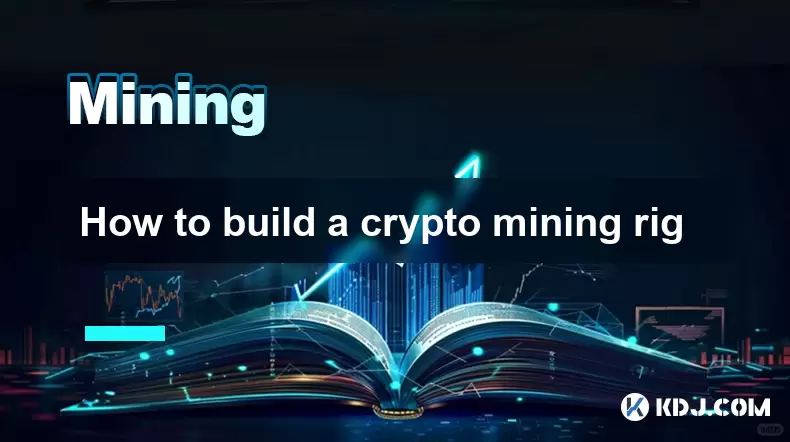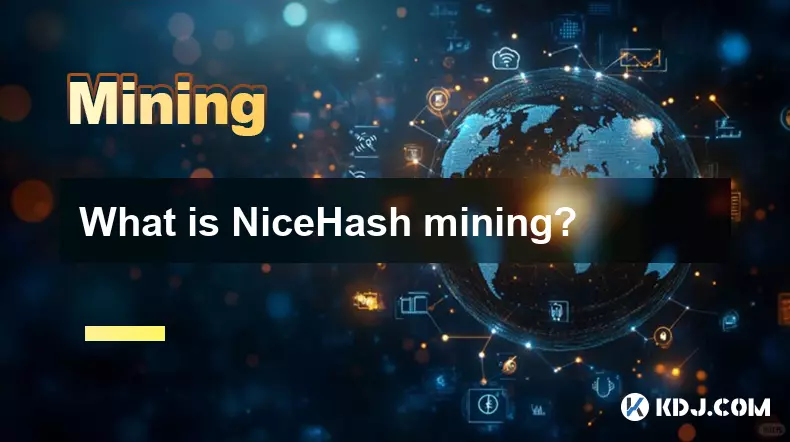-
 bitcoin
bitcoin $101752.865364 USD
-1.09% -
 ethereum
ethereum $3382.985899 USD
-1.38% -
 tether
tether $0.999658 USD
0.04% -
 xrp
xrp $2.272505 USD
-1.51% -
 bnb
bnb $989.089004 USD
0.14% -
 solana
solana $156.962612 USD
-3.08% -
 usd-coin
usd-coin $0.999776 USD
0.01% -
 tron
tron $0.290786 USD
-0.69% -
 dogecoin
dogecoin $0.174594 USD
-2.86% -
 cardano
cardano $0.560085 USD
-3.55% -
 hyperliquid
hyperliquid $40.023704 USD
-5.75% -
 chainlink
chainlink $15.324649 USD
-2.78% -
 bitcoin-cash
bitcoin-cash $493.576540 USD
-3.52% -
 zcash
zcash $571.320038 USD
-12.05% -
 stellar
stellar $0.280066 USD
-4.26%
How to build a crypto mining rig
A crypto mining rig is a specialized computer system built to efficiently mine cryptocurrencies by solving complex blockchain puzzles using high-performance GPUs and optimized hardware.
Jul 15, 2025 at 11:08 am

What is a Crypto Mining Rig?
A crypto mining rig refers to a specialized computer system designed specifically for mining cryptocurrencies like Bitcoin, Ethereum, or Litecoin. Unlike standard desktop computers, these rigs are optimized for high computational performance and energy efficiency. The primary purpose of a mining rig is to solve complex mathematical problems that validate transactions on a blockchain network. Miners who successfully solve these problems are rewarded with cryptocurrency. To build a crypto mining rig, it's essential to understand the components involved and how they contribute to mining performance.
Choosing the Right Components
Building a mining rig starts with selecting the appropriate hardware. One of the most crucial components is the GPU (Graphics Processing Unit). High-performance GPUs such as the NVIDIA RTX 3060 Ti or AMD Radeon RX 6700 XT are popular choices due to their excellent hash rate and power efficiency. In addition to the GPU, you'll need a motherboard that supports multiple GPUs, such as models from ASRock or MSI that come with multiple PCIe slots. A power supply unit (PSU) with sufficient wattage is also vital; a 1200W PSU is typically recommended for multi-GPU setups. Other essential components include a processor (CPU), which doesn't need to be top-tier but should be reliable, a basic RAM configuration (8GB is usually enough), and a storage solution like an SSD or USB drive for the operating system.
Assembling the Mining Rig
Once all components are gathered, the next step is assembling the mining rig. Begin by installing the CPU onto the motherboard, followed by the RAM. Connect the power supply unit to the motherboard and install the GPUs into the PCIe slots. Use riser cables to connect additional GPUs if your motherboard supports them. It's important to ensure proper airflow and cooling, so mount case fans or set up a cooling system to prevent overheating. Secure all components inside a rig case or open frame for stability. After assembly, double-check all connections before powering on the system to avoid any short circuits or hardware damage.
Installing the Operating System and Mining Software
After physically building the rig, it's time to install the operating system (OS). Many miners prefer lightweight OS options like Windows 10 or specialized mining OS such as HiveOS or EthOS. Once the OS is installed, update the GPU drivers to ensure compatibility and optimal performance. Next, download and configure mining software based on the cryptocurrency you intend to mine. For Ethereum, Claymore’s Dual Miner or PhoenixMiner are widely used. For other coins, tools like CGMiner or BFGMiner may be more suitable. Configure the mining software with your wallet address and the mining pool server details to start mining.
Configuring Mining Pool and Wallet
To maximize mining efficiency, joining a mining pool is highly recommended. A mining pool allows multiple miners to combine their computational power and share rewards proportionally. Choose a reputable mining pool like Ethermine, F2Pool, or Sparkpool, depending on the cryptocurrency you're targeting. Create an account and note down the server addresses and port numbers provided by the pool. Then, set up a cryptocurrency wallet to receive mining rewards. Popular wallet options include MetaMask for Ethereum-based coins and Electrum for Bitcoin. Ensure your wallet address is correctly entered in the mining software configuration to receive payouts directly.
Optimizing Performance and Power Efficiency
After everything is set up, optimizing the rig for performance and power efficiency becomes critical. Overclocking the GPUs can increase hashrate, but it must be done cautiously to avoid instability or overheating. Tools like MSI Afterburner allow users to tweak GPU clock speeds and voltage settings. Monitoring temperatures using software like HWInfo or GPU-Z helps ensure that the rig stays within safe thermal limits. Additionally, adjusting the BIOS settings of the motherboard can improve power delivery and stability. Regular maintenance, including cleaning dust from fans and checking for loose connections, ensures long-term reliability.
Frequently Asked Questions
Q: Can I use integrated graphics instead of a dedicated GPU for mining?Integrated graphics lack the processing power required for efficient cryptocurrency mining. Dedicated GPUs offer significantly higher hash rates and are necessary for competitive mining operations.
Q: Is it possible to mine multiple cryptocurrencies simultaneously?Yes, some mining software supports dual mining, allowing you to mine two cryptocurrencies at once. For example, while mining Ethereum, you can also mine another coin like Ravencoin using compatible software and configurations.
Q: How much electricity does a mining rig consume?Electricity consumption depends on the number of GPUs and their power draw. A typical 6-GPU rig with each GPU consuming around 100-150W can use approximately 600-900W per hour. Always calculate power costs before starting mining.
Q: Do I need an internet connection to mine cryptocurrency?Yes, a stable internet connection is required to communicate with the mining pool servers and submit proof-of-work solutions. However, offline solo mining is technically possible but not recommended due to low success rates.
Disclaimer:info@kdj.com
The information provided is not trading advice. kdj.com does not assume any responsibility for any investments made based on the information provided in this article. Cryptocurrencies are highly volatile and it is highly recommended that you invest with caution after thorough research!
If you believe that the content used on this website infringes your copyright, please contact us immediately (info@kdj.com) and we will delete it promptly.
- Ripple (XRP) in 2026: Hold or Fold? A Look at XRP's Future and Emerging DeFi Alternatives
- 2025-11-08 18:35:01
- Zcash ZEC Coin Price Explosion: From Privacy Niche to Center Stage
- 2025-11-08 18:55:01
- Berachain Price Prediction: Navigating the Honeycomb Hype in Crypto
- 2025-11-08 18:55:01
- Arthur Hayes, Gold, and Bitcoin: A Modern Monetary Trinity?
- 2025-11-08 19:15:01
- Shiba Inu's Next Move: Navigating a Shifting Market
- 2025-11-08 19:20:01
- Pakistan's Crypto Crossroads: Balancing Opportunity with Asset-Backed Realities
- 2025-11-08 19:20:01
Related knowledge

What is the block reward in mining?
Nov 06,2025 at 12:35am
Understanding Block Rewards in Cryptocurrency Mining1. The block reward is the incentive miners receive for successfully validating and adding a new b...

How do mining algorithms work?
Nov 06,2025 at 04:59am
Mining Algorithms and Their Role in Blockchain Networks1. Mining algorithms serve as the backbone of blockchain consensus mechanisms, ensuring that tr...

What is NiceHash mining?
Nov 06,2025 at 07:40am
NiceHash mining refers to the process of renting out computational power to individuals or organizations seeking to mine cryptocurrencies without owni...

Does an antivirus program affect mining?
Nov 05,2025 at 09:29pm
Understanding Decentralized Exchanges in the Crypto Ecosystem1. Decentralized exchanges (DEXs) operate without a central authority, allowing users to ...

What is the history of Bitcoin mining?
Nov 05,2025 at 08:15pm
Within the fast-moving world of cryptocurrency, new developments emerge daily, reshaping how investors, developers, and institutions interact with dig...

How is the energy consumption of mining justified?
Nov 05,2025 at 10:20pm
Energy Consumption in Cryptocurrency Mining1. The energy consumption associated with cryptocurrency mining has drawn significant attention from enviro...

What is the block reward in mining?
Nov 06,2025 at 12:35am
Understanding Block Rewards in Cryptocurrency Mining1. The block reward is the incentive miners receive for successfully validating and adding a new b...

How do mining algorithms work?
Nov 06,2025 at 04:59am
Mining Algorithms and Their Role in Blockchain Networks1. Mining algorithms serve as the backbone of blockchain consensus mechanisms, ensuring that tr...

What is NiceHash mining?
Nov 06,2025 at 07:40am
NiceHash mining refers to the process of renting out computational power to individuals or organizations seeking to mine cryptocurrencies without owni...

Does an antivirus program affect mining?
Nov 05,2025 at 09:29pm
Understanding Decentralized Exchanges in the Crypto Ecosystem1. Decentralized exchanges (DEXs) operate without a central authority, allowing users to ...

What is the history of Bitcoin mining?
Nov 05,2025 at 08:15pm
Within the fast-moving world of cryptocurrency, new developments emerge daily, reshaping how investors, developers, and institutions interact with dig...

How is the energy consumption of mining justified?
Nov 05,2025 at 10:20pm
Energy Consumption in Cryptocurrency Mining1. The energy consumption associated with cryptocurrency mining has drawn significant attention from enviro...
See all articles





















![The Graph Price Prediction [GRT Crypto Price News Today] The Graph Price Prediction [GRT Crypto Price News Today]](/uploads/2025/11/07/cryptocurrencies-news/videos/690d4df44fe69_image_500_375.webp)




















































